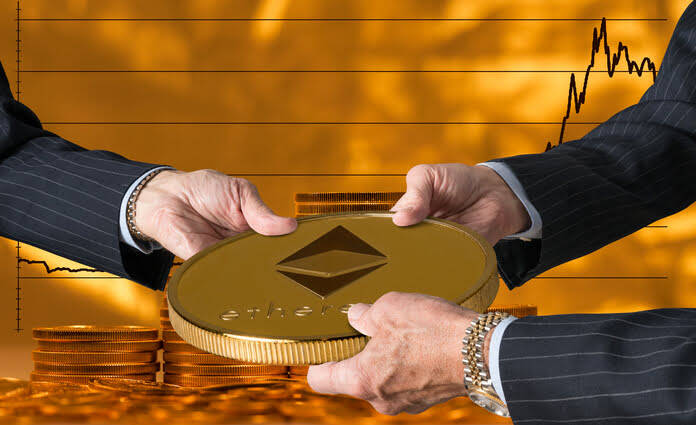As the ETH exchange balance rises, Ethereum traders are banking on a “sell-the-news” scenario on the day of the Merge.
On September 15, Ethereum’s long-awaited shift to proof-of-stake was accomplished via “the Merge,” while traders have been steadily shorting Ether (ETH) in anticipation of a sell-the-news event.
Ethereum Funding Rate Falls Dramatically
Before the Merge, Ether’s futures funding rates on prominent derivatives platforms fell below zero, reaching their lowest levels. For example, on BitMex, the rate fell as low as -0.6%. Funding rates are calculated as a proportion of the fee paid to either short or long position holders. The platform determines the charge based on the difference between the perpetual futures contract and the spot price. As a result, when the financing rate is positive, traders believe the market to be optimistic. A negative funding rate, on the other hand, indicates a gloomy market attitude. Let’s look at an example to see why.
Ether’s financing rate is now at -0.1% on average. In other words, traders holding a $1 million short ETH position are prepared to pay $1,000 every eight hours to those with bullish ones (based on when platforms recalculate the funding rates). This demonstrates traders’ belief in a possible spot Ether price decline following the Merge. On the other hand, a continually negative financing rate raises the potential for a short squeeze.
A short squeeze happens when an asset climbs higher and short traders opt to cover their positions or are compelled to do so due to margin calls, contributing to the asset’s price’s upward strength.
Technical Analysis of the Ethereum Price Suggests a 50% Drop.
Technically, Ether’s price might decline by 50% in the following weeks owing to the emergence of a symmetrical triangle on its longer-term chart. Notably, symmetrical triangles are trend continuation patterns, which means that following a consolidation phase, the price will often continue in the direction of its prior trend. As a result, Ether’s symmetrical triangle pattern seems bearish, especially given the token’s 80% drop from its November 2021 highs. In theory, the downside target of a bearish symmetrical triangle is computed by subtracting the triangle’s greatest height from the breakdown point. That sets the profit objective for ETH in 2022 at roughly $850.
Capital Rotation Into Bitcoin
Aside from negative financing rates and the symmetrical triangle configuration, Ether is also vulnerable to a revived purchasing interest in Bitcoin (BTC), the top cryptocurrency by market capitalization. On the daily chart, ETH/BTC fell to 0.078 BTC on September 15, nearly a week after peaking at 0.085 BTC.
The pair’s price fell following a full bull cycle in which it surged by more than 75% in less than three months.
“ETH’s underperformance ahead of the merging shows that some traders are attempting to front run a potential “sell-the-news” event,” Arcane Research stated in its weekly analysis, adding that “whether or not the merge will turn out to be sell-the-news’ event remains to be seen.” In addition, CoinShares, an investment management organization, revealed a significant drop in the capital of Bitcoin and Ethereum-based investment products in another weekly report amidst reports that crypto might rise soon.
However, withdrawals from Ether funds were $61.6 million in the week ending September 9, compared to $13 million for Bitcoin. A recent increase in Ethereum’s balance across all crypto exchanges provides further sell-the-news clues. The exchange inflows reached a one-month high of 22,723.289 ETH (7-day MA). When traders wish to sell their bitcoin holdings, they often boost their cryptocurrency deposits on exchanges. In other words, as the value of ETH on exchanges rises, so do the dangers.
The long-awaited Ethereum Merge has occurred, and the community is ecstatic. One user mined the first ever nonfungible token (NFT) on the proof-of-stake (PoS) consensus moments after the historic crypto event. The Merge officially occurred on September 15 at 06:42:42 UTC at block 15537393. At 07:08 UTC, the initial announcement of the minting and selling of the NFT was made.
The NFT, a time capsule of the original NFT mint and the distinctive panda face, was soon acquired for 36 Ether (ETH). Crypto Twitter exploded with retweets and conversation following the launch of the first PoS NFT. Reactions in the community varied from “questionable decision making” to labeling it “fire.” One user even wondered whether the Merge panda would be the new ape, referring to the classic Bored Ape Yacht Club personalities.
Following the announcement of the first NFT mint and sale, an avalanche of firsts for the new blockchain operating system began.
Bloom’s creator, Sheldon Evans, stated that the company generated the first official NFT collection to mint on the PoS network. While some proudly showcase their first digital assets and supplies, others in the Ethereum community proudly display their first Ethereum purchases. Consensys, Joseph Lubin’s blockchain software startup, is also urging community members to make their first PoS transaction by minting one of their commemorative NFTs commemorating the Merge. Big figures like Beeple, who drew a Merge-inspired artwork of a giant slowly developing Ethereum logo supported by scientists, have also been influenced by the Merge. Members of the Ethereum Foundation also got creative, writing and performing a song in honor of the event.
Co-founder Vitalik Buterin expressed his enthusiasm and PoS goal with the community moments before the significant Ethereum Merge. As the clock approached the closing seconds before the vast Ethereum Merge, co-founder Vitalik Buterin joined the Ethereum Foundation’s Ethereum Mainnet Merge Viewing Party webcast to provide his final views.
When asked if he was thrilled about the Merge, Buterin said, “totally excited about exiting the proof-of-work period.” The co-founder went on to add that the network’s historic move from proof-of-work (PoW) to proof-of-stake (PoS) has been on the schedule for years: “[It] has certainly been a goal for the Ethereum ecosystem pretty much since the beginning.” We began the proof-of-stake investigation in January 2014, with the blog post on Slosher.”
According to Buterin, the Merge can be viewed as rewriting the laws of physics. PoW uses real-world characteristics such as energy, hardware, and computers. PoS, on the other hand, virtualizes everything, “essentially allowing us to build a simulated cosmos with its own rules of physics.” Buterin stated that the exorbitant expenses and large volume of energy use are two of the most compelling reasons for the transition. The Merge is claimed to minimize energy usage by 99.95%.
He further stated that this will benefit not just the environment, which has been a hot subject among environmentalists about the crypto sector, but also “non-environmental externalities.” The GPU price increase caused by Ether (ETH) mining was an example. The Merge ultimately happened on Thursday at 06:42:42 UTC at block 15537393, just after Vitalik’s small spotlight on the Livestream.
At the Terminal Total Difficulty of 58750000000000000000000, the Ethereum mainnet execution layer and the Beacon Chain’s consensus layer merged. As a result, the network no longer uses a proof-of-work (PoW) consensus process after the Merge.
Buterin praised the community and heralded the start of Ethereum’s new era on Twitter: These new improvements enable developers and users to grow the network in previously impossible or unsustainable ways. This is a significant step toward mainstream adoption of decentralized technology and bringing the next billion into the ecosystem.
Featured Image: Megapixl @ Steveheap



